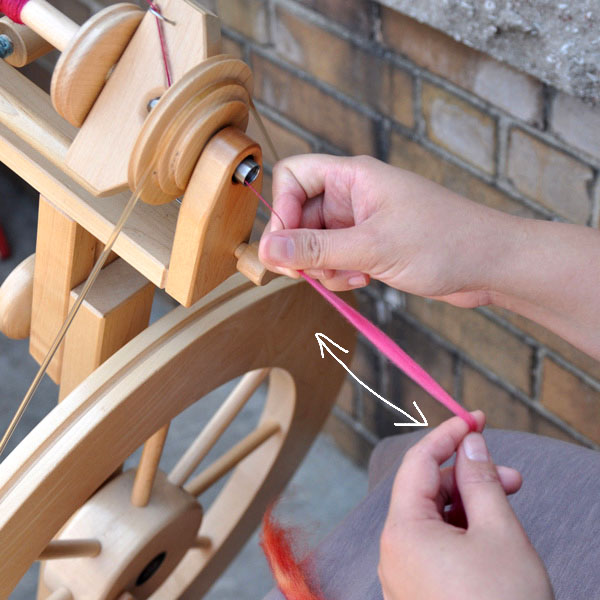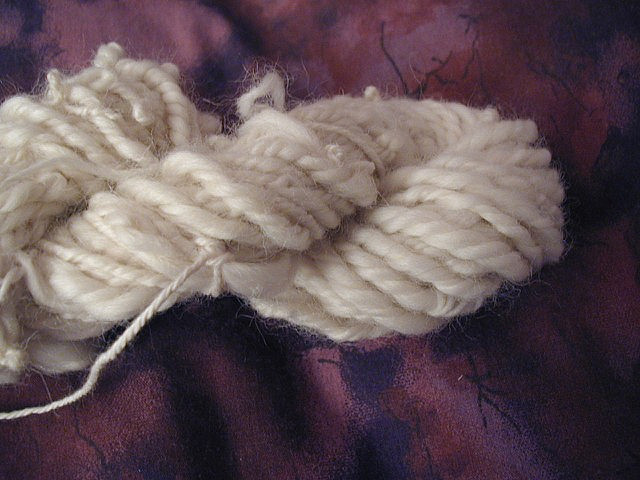Practice, practice, practice. When it comes to learning how to spin yarn, the MOST important thing you can do is to keep practicing! It might not seem like you’ll ever get there, but eventually muscle memory will kick in and things will flow…at least for a moment. Once you’ve got the motions down, it becomes much easier to analyze your yarn and make changes, so that you can get the yarn you actually want. Read on to discover some solutions and ideas for the most common issues for drafting yarn and plying yarn while working with a spinning wheel.

Why is my yarn so twisty/curly/hard?
Hard, ropey yarn, coils and assorted twisty bits are caused by an excess of twist. These can be used to great effect, if you want! But adding too much twist to your fiber is very easy to do, especially when you’re starting out and don’t quite have the feel for things yet.
Overspinning is caused by either adding twist too quickly, or drafting too slowly. Some of the twist will be taken out if you’re plying yarn, but if you have hard coils that don’t want to move, it probably won’t be enough!
Practically, there are a few adjustments you can make if you want less twist:
- Move your drive band to a larger whorl. The lower spinning wheel ratio will slow down the rate at which twist enters the yarn.
- Treadle more slowly, perhaps even stopping altogether while drafting yarn. It’s very easy to want to treadle as fast as you can, but if your hands can’t keep up then it’s not very useful!
- Increase the brake tension (make the brake band tighter). This will draw the yarn into the orifice more quickly, so there’s less time for the twist to enter the yarn.
- Learn to draft faster. This is the most difficult one!
Why is my yarn breaking?
Not enough twist! If you go a little too far in reducing the amount of twist that enters the yarn, you might find that the yarn breaks while winding, plying or knitting. Stop every once in a while and give your yarn a good tug — it should drift apart unless you are *really* trying.
Tips for adding more twist are pretty much just the opposite of taking out twist — treadle faster, draft slower or move your drive band to a smaller whorl (greater ratio). If you find that your yarn breaks over joins, make a conscious effort to increase the amount of twist in that area before letting it wind on.
My yarn is too thick or thin!
Again, consistency comes with practice (frustrating, isn’t it?). Pre-drafting can help give you a more consistent base to draft from, but isn’t really the be-all and end-all of yarn thickness. It’s all about managing your drafting. If it looks like a section is going to be too thick, you can always stop treadling, untwist the section a bit with your fingers, and draft out a little more. If it looks a little too thin, you can always break the fiber and re-join. But embrace the thick and thin! Texture is fun.

Photo via Laura Chau
Why can’t I draft?
Twist is an active thing, and always wants to glue your fiber together! Most likely, twist has gotten into your fiber supply. If it’s just a little bit twisted, you can try unwinding the fiber supply with your hands or pulling the fiber supply back to spread out the twist enough to draft.
But if it’s really bunched up or so twisted that you can’t unfurl it, break the yarn and let the twist out before continuing. Make sure you’re pinching the yarn to prevent twist from traveling up into your fiber supply in the future.
 Everyone has to start somewhere! This was my first attempt at chain plying – it’s not very good!
Everyone has to start somewhere! This was my first attempt at chain plying – it’s not very good!
My yarn doesn’t seem to want to ply together!
Are you you spinning in the correct direction? Singles are generally spun with the wheel turning clockwise, then plied together with the wheel turning counterclockwise. You can absolutely spin singles counterclockwise as well, but make sure then that you’re plying yarn the opposite way.

It would be helpful for Craftsy to add links to Craftsy classes that correct the issue. Eg class on plying